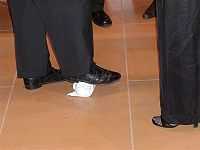Jewish wedding


.jpg)





A Jewish wedding is a wedding ceremony that follows Jewish law and traditions.
While wedding ceremonies vary, common features of a Jewish wedding include a ketubah (marriage contract) which is signed by two witnesses, a wedding canopy (chuppah or huppah), a ring owned by the groom that is given to the bride under the canopy, and the breaking of a glass.
Technically, the Jewish wedding process has two distinct stages:[1] kiddushin (sanctification or dedication, also called erusin, betrothal in Hebrew) and nissuin (marriage), when the couple start their life together. The first stage prohibits the woman to all other men, requiring a religious divorce (Get) to dissolve, and the final stage permits the couple to each other. The ceremony that accomplishes nisuin is known as chuppah.[2]
Today, erusin/kiddushin occurs when the groom gives the bride a ring or other object of value with the intent of creating a marriage. There are differing opinions as to which part of the ceremony constitutes nissuin/chuppah; they include standing under the canopy - itself called a chuppah - and being alone together in a room (yichud).[2] While historically these two events could take place as much as a year apart,[3] they are now commonly combined into one ceremony.[2]
Signing of the marriage contract
Before the wedding ceremony, the groom (chatan) agrees to be bound by the terms of the ketubah, or marriage contract, in the presence of two witnesses, whereupon the witnesses sign the ketubah.[4] The ketubah details the obligations of one partner to another, among which are food, clothing, and marital relations. This document has the standing of a legally binding agreement. It is often written as an illuminated manuscript that is framed and displayed in their home.[5] Under the chuppah, it is traditional to read the signed ketubah aloud, usually in the Aramaic original, but sometimes in translation. Traditionally, this is done to separate the two basic parts of the wedding.[6] Secular couples may opt for a shortened version to be read out.
Bridal canopy
A traditional Jewish wedding ceremony takes place under a Chuppah or wedding canopy, symbolizing the new home being built by the couple when they become husband and wife.[7][8]
Covering of the bride
Prior to the ceremony, Ashkenazi Jews have a custom to cover the face of the bride (usually with a veil), and a prayer is often said for her based on the words spoken to Rebecca in Genesis 24:60.[9] The veiling ritual is known in Yiddish as badeken. Various reasons are given for the veil and the ceremony, a commonly accepted reason is that it reminds the Jewish people of how Jacob was tricked by Laban into marrying Leah before Rachel, as her face was covered by her veil.(Vayetze)[10] Sephardic Jews do not perform this ceremony.
Unterfirers
In many communities, the groom is led under the chuppah by the two fathers and the bride by the two mothers,[11] known as unterfirers (lit. ones who lead under).
Encircling the groom
The bride traditionally walks around the groom three or seven times when she arrives at the Chuppah. This may derive from Jeremiah 31:22, “A woman shall surround a man”. The three circuits may represent the three virtues of marriage: righteousness, justice and loving kindness (see Hosea 2:21). Seven circuits derives from the Biblical concept that seven denotes perfection or completeness.[11] Sephardic Jews do not perform this ceremony.[12]
Presentation of the ring (Betrothal)
In traditional weddings, two blessings are recited before the betrothal; a blessing over wine, and the betrothal blessing, which is specified in the Talmud.[13] The wine is then tasted by the couple.[14]
The groom gives the bride a ring, traditionally a plain wedding band,[15] and recites the declaration: Behold, you are consecrated to me with this ring according to the law of Moses and Israel. The groom places the ring on the bride’s right index finger. According to traditional Jewish law, two valid witnesses must see him place the ring.[14]
During some egalitarian weddings, the bride will also present a ring to the groom,[16][17] often with a quote from the Song of Songs: "Ani l'dodi, ve dodi li" (I am my beloved's and my beloved is mine), which may also be inscribed on the ring itself.[18][19] This ring is sometimes presented outside the chuppa to avoid conflicts with Jewish law.[20][21][22]
Seven blessings
The Sheva Brachot or seven blessings are recited by the hazzan or rabbi, or by select guests who are called up individually. Being called upon to recite one of the seven blessings is considered an honour. The groom is given the cup of wine to drink from after the seven blessings. The bride also drinks the wine. In some traditions, the cup will be held to the lips of the groom by his new father-in-law and to the lips of the bride by her new mother-in-law.[23] Traditions vary as to whether additional songs are sung before the seven blessings.
Breaking the glass
After the bride has been given the ring, or at the end of the ceremony (depending on local custom), the groom breaks a glass, crushing it with his right foot, and the guests shout "Mazel tov!" ("Congratulations"). At some contemporary weddings, a lightbulb may be substituted because it is thinner and more easily broken, and it makes a louder popping sound.[24]
The origin of this custom is unknown, although many reasons have been given. The primary reason is that joy must always be tempered.[25] This is based on two accounts in the Talmud of rabbis who, upon seeing that their son's wedding celebration was getting out of hand, broke a vessel - in the second case a glass - to calm things down. Another explanation is that it is a reminder that despite the joy, Jews still mourn the destruction of the Temple in Jerusalem. Because of this, some recite the verses "If I forget thee / O Jerusalem..." at this point.[15] Many other reasons have been given by traditional authorities.[25]
Former Sephardic Chief Rabbi of Israel Ovadia Yosef, has strongly criticized the way this custom is sometimes carried out, arguing that "Many unknowledgeable people fill their mouths with laughter during the breaking of the glass, shouting 'mazel tov' and turning a beautiful custom meant to express our sorrow" over Jerusalem's destruction "into an opportunity for lightheadedness." [26]
Yichud
Yichud (Hebrew for "togetherness" or "seclusion") refers to the Ashkenazi practice of leaving the bride and groom alone for 10–20 minutes after the wedding ceremony. The couple retreats to a private room. Yichud can take place anywhere, from a rabbi's study to a synagogue classroom.[27] The reason for yichud is that according to several authorities, standing under the canopy alone does not constitute chuppah, and seclusion is necessary to complete the wedding ceremony.[2] However, Sephardic Jews do not have this custom, as they consider it a davar mechoar, a "repugnant thing", compromising the couple's modesty.[28]
Special dances
Dancing is a major feature of Jewish wedding. It is customary for the guests to dance in front of the seated couple and entertain them.[29] Traditional dances include:
- The Krenzl, in which the bride's mother is crowned with a wreath of flowers as her daughters dance around her (traditionally at the wedding of the mother's last unwed daughter).
- The Mizinke, a dance for the parents of the bride or groom when their last child is wed.
- The "Horah" is a Middle Eastern/Israeli style dance[30] usually played as a second dance set.
- The gladdening of the bride, in which guests dance around the bride, and can include the use of "shtick"—silly items such as signs, banners, costumes, confetti, and jump ropes made of table napkins.
- The Mitzvah tantz, in which family members and honored rabbis are invited to dance in front of the bride (or sometimes with the bride in the case of a father or grandfather), often holding a gartel, and then dancing with the groom. At the end the bride and groom dance together themselves.
Birkat hamazon and sheva brachot
After the meal, Birkat Hamazon (Grace after meals) is recited, followed by sheva brachot. At a wedding banquet, the wording of the blessings preceding Birkat Hamazon is slightly different from the everyday version.[31] Prayer booklets called benchers, may be handed out to guests. After the prayers, the blessing over the wine is recited, with two glasses of wine poured together into a third, symbolizing the creation of a new life together.[29]
Jewish prenuptial agreements
In recent years, the governing bodies of several branches of Judaism have developed standard Jewish prenuptial agreements designed to prevent a man from withholding a get (Jewish bill of divorce) from his wife, should she want one. Such documents have been developed and widely used in the United States, Israel, the United Kingdom and other places.
See also
References
- ↑
 This article incorporates text from a publication now in the public domain: "marriage ceremonies". Jewish Encyclopedia. 1901–1906.
This article incorporates text from a publication now in the public domain: "marriage ceremonies". Jewish Encyclopedia. 1901–1906.
- ↑ 2.0 2.1 2.2 2.3 Made in Heaven, A Jewish Wedding Guide by Rabbi Aryeh Kaplan, Moznaim Publishing Company, New York / Jerusalem, 1983, Chapter 18
- ↑ Talmud Bavli, Ketubot, page 2
- ↑ Jewish wedding traditions
- ↑ The Jewish Wedding Ceremony
- ↑ Made in Heaven, A Jewish Wedding Guide by Rabbi Aryeh Kaplan, Moznaim Publishing Company, New York / Jerusalem, 1983, Chapter 21
- ↑ "Chuppah". Jewish-wedding-planner.com. Retrieved 2012-11-09.
- ↑ "View Chuppah listings and search for Simchas listings". Jewpro.co.uk. Retrieved 2012-11-09.
- ↑
 This article incorporates text from a publication now in the public domain: "Veil". Jewish Encyclopedia. 1901–1906.
and A guide to the marriage ceremony
This article incorporates text from a publication now in the public domain: "Veil". Jewish Encyclopedia. 1901–1906.
and A guide to the marriage ceremony - ↑ Made in Heaven, A Jewish Wedding Guide by Rabbi Aryeh Kaplan, Moznaim Publishing Company, New York / Jerusalem, 1983, Chapter 17
- ↑ 11.0 11.1 A guide to the marriage ceremony
- ↑ Made in Heaven, A Jewish Wedding Guide by Rabbi Aryeh Kaplan, Moznaim Publishing Company, New York / Jerusalem, 1983, Chapter 19
- ↑ Ketuboth 7b
- ↑ 14.0 14.1 Made in Heaven, A Jewish Wedding Guide by Rabbi Aryeh Kaplan, Moznaim Publishing Company, New York / Jerusalem, 1983, Chapters 20 and 21
- ↑ 15.0 15.1 The Jewish Way in Love & Marriage, Rabbi Maurice Lamm, Harper & Row, 1980, Chapter 15
- ↑ "Jewish Wedding Ring". Judaism.about.com. 2009-12-17. Retrieved 2012-11-09.
- ↑ "Wedding Vows: Jewish Wedding VowsTheKnot.com". Wedding.theknot.com. Retrieved 2012-11-09.
- ↑ Marlena Thompson. "Jewish Life Cycle/Rituals: Marriage". Jewishfederations.org. Retrieved 2012-11-09.
- ↑ "Shalom! Rabbi Dina-Hasida Mercy on Marriage". Rabbi-mercy.com. 2009-02-18. Retrieved 2012-11-09.
- ↑ "June 2010, Rethinking Jewish Weddings". Shmadigital.com. 2010-06-03. Retrieved 2012-11-09.
- ↑ Chaplain (CPT) Shlomo Shulman (2001-06-30). "Guide to the Jewish Wedding: Jewish wedding program, jewish wedding traditions, Chuppah, Ketubah". Aish.com. Retrieved 2012-11-09.
- ↑
- ↑ "The Jewish Wedding". Beingjewish.com. Retrieved 2012-11-09.
- ↑ Get smashed… & mazel tov
- ↑ 25.0 25.1 Made in Heaven, A Jewish Wedding Guide by Rabbi Aryeh Kaplan, Moznaim Publishing Company, New York / Jerusalem, 1983, Chapters 20 and 22
- ↑ "Rabbi Yosef Criticizes Custom - Jewish World - News". Israel National News. 2010-02-13. Retrieved 2012-11-09.
- ↑ Yichud, a Romantic Oasis
- ↑ "Marriage". Jewishvirtuallibrary.org. 1996-11-08. Retrieved 2012-11-09.
- ↑ 29.0 29.1 Wedding receptions: Jewish Reception Rituals
- ↑ Jewish Wedding Dances Videos
- ↑ Birkat Hamazon
| Wikimedia Commons has media related to Jewish weddings. |
| |||||||||||||||||||||||||
| ||||||||||||||||


